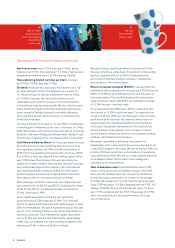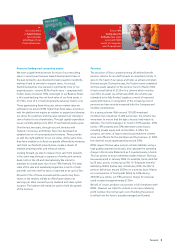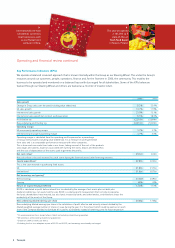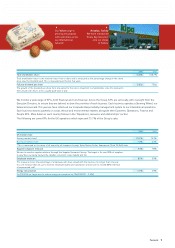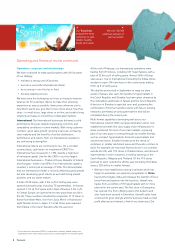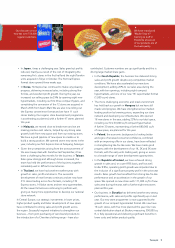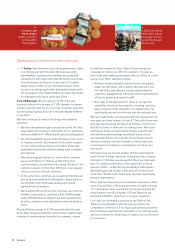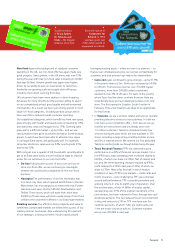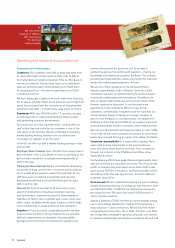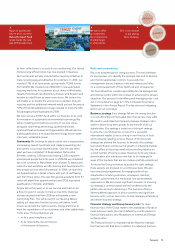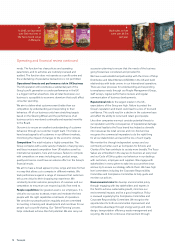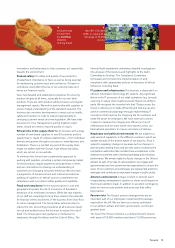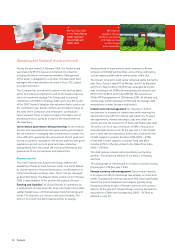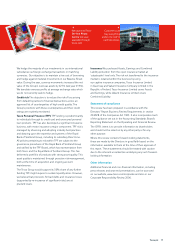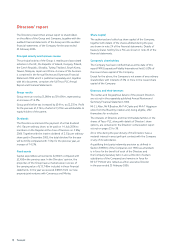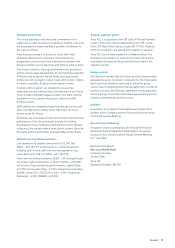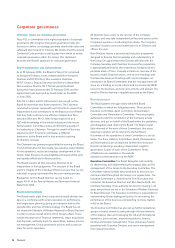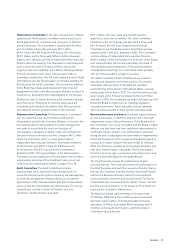Tesco 2006 Annual Report Download - page 16
Download and view the complete annual report
Please find page 16 of the 2006 Tesco annual report below. You can navigate through the pages in the report by either clicking on the pages listed below, or by using the keyword search tool below to find specific information within the annual report.
14 Tesco plc
Operating and financial review continued
needs. The function has clear policies and operating
parameters, and its activities are routinely reviewed and
audited. The function does not operate as a profit centre and
the undertaking of speculative transactions is not permitted.
Operational threats and performance risk in UK business
The UK operation still constitutes a substantial part of the
Group’s profit generation so under-performance in the UK
is a bigger risk than elsewhere. Like all retail businesses our
business is susceptible to economic downturn that could affect
consumer spending.
We aim to deliver what customers want better than our
competitors by understanding and responding to their
behaviour. All of our business units have stretching targets
based on the Steering Wheel and the performance of all
business units is monitored continually and reported monthly
to the Board.
Our aim is to ensure an excellent understanding of customer
behaviour through our customer insight team. This helps us
have broad appeal toall customers in our different markets,
minimising the impactof changes to the economic climate.
Competition The retail industry is highly competitive. The
Group competes with a wide variety of retailers of varying sizes,
and faces increased competition from UK retailers as well as
international operators, here and overseas. Failure to compete
with competitors on areas including price, product range,
quality and service could have an adverse effect on the Group’s
financial results.
Weaim tohave a broad appeal in price, range and store format
in a way that allows us to compete in different markets. We
track performance against a range of measures that customers
tell us arecritical totheir shopping trip experience. We
constantly monitor customer perceptions of ourselves and our
competitors to ensure we can respond quickly if we need to.
People capabilities Our greatest asset is our employees. It is
critical to our success to attract, retain and motivate the best
people with the right capabilities at all levels of operations.
We consider our people policies regularly and are committed
to investing in training and development and incentives for our
people such as profit-sharing. Our ‘Talent Planning’ process
helps individuals achieve their full potential. We also carry out
succession planning to ensure that the needs of the business
going forward are considered and provided for.
Wehave a well-established partnership with the Union of Shop
Distributive and Allied Workers (USDAW) in the UK and build
relationships with trade unions in our International operations.
There are clear processes for understanding and responding
to employees needs through our People Management Group,
staff surveys, regular performance reviews and regular
communication of business developments.
Reputational risk As the largest retailer in the UK,
expectations of the Group are high. Failure to protect the
Group’s reputation and brand could lead to a loss of trust and
confidence. This could result in a decline in the customer base
and affect the ability to recruit and retain good people.
Like other companies we must consider potential threats to
our reputation and the consequences of reputational damage.
Emotional loyalty to the Tesco brand has helped us diversify
into new areas like retail services and non-food and we
recognisethe commercial imperative to do the right thing
for all our stakeholders and avoid the loss of such loyalty.
Wemonitor this through independent surveys and our
community schemes such as Computers for Schools and
Charity of the Year contribute to society more broadly. The Tesco
Values are embedded in the way we do business at every level
and our Code of Ethics guides our behaviour in our dealings
with customers, employees and suppliers. We engage with
stakeholders in every sphere to take into account their views
and wetry to ensure our strategy reflects them. We have high
level committees including the Corporate Responsibility
Committee and Compliance Committee to help guide and
monitor our policies.
Environmental risks We develop environmental policy
through engaging with key stakeholders and experts in
this field toachieve sustainable growth, minimise our
environmental impacts and be a good neighbour. Policy
is reviewed regularly by the Compliance Committee and
Corporate Responsibility Committee. We recognise the
opportunities for both environmental improvement and
competitive advantage through energy savings and store
design, transportation efficiency, waste management and
recycling. We look for continuous improvement through
4
In 2005, we launched
over 300 new lines in
the Tesco brand range
in Malaysia.
4
Book sales on-line
were over £4.5m
last year.


